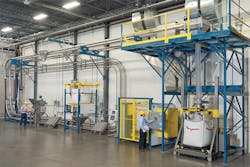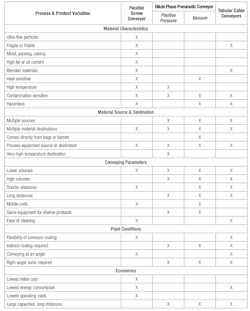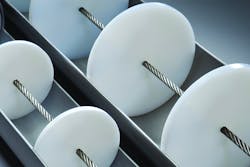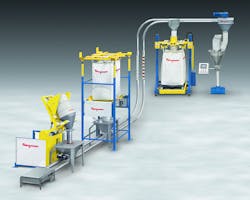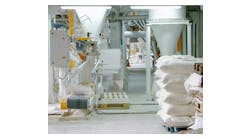Pros and cons of pneumatic and mechanical conveying of bulk solid materials
Everyone has rules of thumb when it comes to choosing a conveying system — rules based on bulk material characteristics, required flow rates and distances, sources and destinations, plant configurations and other variables. But those with experience in all types of systems will understand that the only rule for choosing a conveying technology is that there are no hard-and-fast rules.
The fact is, most materials can be conveyed using any of several methods. No one can say with certainty, for example, that positive pressure pneumatic conveying is always the better choice for conveying high-temperature materials, or that a tubular cable conveyor is the only option for handling fragile or friable material. The final selection comes down to balancing the pros and cons of each type of system for the particular application, with all its variables. That said, the following guidelines will help in selecting the optimum method for conveying different types of bulk solid products.
The first rule
The first rule is: Ask the experts. While the science of conveying has advanced significantly over the past several decades, there is still an art to selecting the best overall system and engineering it to meet individual needs. The final analysis requires an intimate understanding of the material and process as they relate to the strengths and limitations of each conveyor technology. Consult with a specialist who does not have a vested interest in selling only one type of equipment. An expert will weigh each parameter and recommend the best solution for each application.
A corollary to the first rule is: Test before buying. Testing will ensure that the specified system will, in fact, convey the subject material the required distance without degradation or undesirable changes in product characteristics. A fully equipped, state-of-the-art testing facility will contain full-size systems that are easily reconfigured, as well as a full range of accessories and peripheral equipment (see Figure 1). It will contain both pneumatic and mechanical bulk handling equipment to produce an objective recommendation based on the actual material to be conveyed. By verifying performance prior to fabrication, costly misjudgments and delays can be avoided in installing and commissioning the system.
Table 1. Parameters for different conveyor types
Equipment comparison
A flexible screw conveyor (see Figure 2), also known as a spiral conveyor, helical conveyor or centerless auger conveyor, consists of a flexible screw contained in a flexible or rigid tube that is driven by an electric motor. Materials of construction are specified according to application, with the screw fabricated of carbon or stainless steel, and the outer tube being of plastic or steel. It is a relatively simple design, and generally the most economical choice, with efficient performance, high reliability and low capital and operating costs. When properly engineered and tested, it will provide excellent performance across a broad range of applications. There are also systems specifically designed to convey difficult-to-handle materials that tend to pack, cake, smear or fluidize, as well as fragile or brittle materials prone to breakage or crumbling.
Pneumatic conveyors (see Figure 3) are also generally custom-engineered for each application and will satisfy a wide range of requirements. They move bulk materials that are suspended in a gas stream (most often air, but sometimes an inert gas) introduced by either a positive pressure blower upstream of material intake points, or by a vacuum pump downstream of material discharge points. Product is separated from the gas stream at the end of the line by filter receivers or cyclone separators or sent directly into process vessels. These systems, which may be more complex than mechanical conveyors, can be integrated into process or production lines and will readily handle diverse products in the same equipment. Positive-pressure pneumatic conveying is generally used to convey materials from a single source to one or multiple destinations, over relatively longer distances and with greater capacity than vacuum systems with similar size conveying lines. Vacuum systems allow easy pickup of materials from open containers using wands, so are better suited to transport material from multiple sources such as storage vessels, process equipment and rail cars to single or multiple destinations.
Tubular cable conveyors (see Figures 4 and 5), also known as drag or disc conveyors, consist of low-friction polymer discs attached to a steel cable. The discs and cable are driven by a wheel at one end of the circuit, while a second wheel maintains the cable’s tension. The entire circuit is enclosed inside steel tubing. Tubular cable conveyors gently slide bulk solid material at relatively slow speeds through this tubing in the space between the discs. A truly "modular" system, tubular cable conveyors can have multiple inlets and outlets (which may be added or moved). The conveyor’s pathway may be horizontal or vertical or at nearly any angle. With outer diameters as small as 4 inches (10 centimeters), tubular cable conveyors can pass through small openings in walls or ceilings.
Figure 2. High-capacity flexible screw conveyor
Choosing a system
The factors to evaluate when selecting a type of conveying system are:
- Material characteristics
- Material source and destination
- Conveying parameters
- Plant conditions
- Economics
- Material characteristics
One of the most important factors to consider is the properties of the material to be conveyed, including bulk density, flow properties, temperature, moisture content, inherent hazards and allowable degree of degradation. Both pneumatic and mechanical conveyors will handle a wide range of products, from fine powders to large particles. Both types can be designed to move materials that are friable or fragile, as well as temperature-sensitive materials.
Individual parameters or a combination of requirements can swing the advantage to one conveyor or other. Pneumatic conveying systems are best suited for dry, free-flowing to semi-free-flowing bulk products. Specially engineered flexible screw conveyors are available for moving more difficult materials that might cause a pneumatic conveyor to plug, and a general purpose screw conveyor to bind or seize. These uniquely designed conveyors have specially engineered screws, tight tolerances and straight conveyor tubes to efficiently handle a broad variety of non-free-flowing products. Examples include materials that are moist such as brown sugar, materials that tend to cake, stick or clump like TiO2 and other pigments, and products like cake mix that have high fat or oil content. With their relatively slower convey line speed, tubular cable conveyors are highly regarded for their ability to gently move shape-sensitive, fragile or friable materials with minimal damage.
Where it is important to maintain temperature and moisture content, exposure to large volumes of air can rule out pneumatics. While it is possible to condition pneumatic conveyor air for temperature and moisture, this adversely impacts the economics, adding considerably to the costs of installing and running the system. These factors may cause either a flexible screw conveyor or a tubular cable conveyor to be a more desirable choice. Flexible screw conveyors and tubular cable conveyors are also the better choice when dealing with blended materials, because unlike dilute-phase pneumatic conveyors, they prevent the separation of blends throughout the entire length of the conveyor, regardless of differences in the flow characteristics or bulk density.
Extremely fine (submicron) powders are best conveyed with a flexible screw system because the amount of dust created by the process is minimal and requires little or no air filtration at the discharge point. Fine particles can make it difficult to keep the filters clean in a pneumatic conveying system, requiring greatly increased area of filtration media, which can add cost and require larger space for installation. Fine particles tend to migrate between the spaces along the edge of the disc and the inner wall of the conveyor tubing in a tubular cable conveyor, which can cause additional drag on the system as well as increased component wear.
The scale tilts toward pneumatic conveying when handling hazardous materials that require inert gas blanketing to prevent explosions, oxidation or other changes in product characteristics, although it is also possible to blanket a mechanical conveyor. When complete containment of a material is necessary, vacuum pneumatic conveying is the method of choice since any breaches in the system will generally leak air into the conveyor, not material into the plant environment. Likewise, with very-high-temperature material, a positive pressure pneumatic conveyor has the advantage. A vacuum system cannot be ruled out, but measures must be taken to protect the air mover and filter media from the heat.
If degradation of product during transport is a concern, all three systems must be properly designed to minimize damage. This is where testing becomes particularly important, especially if there are no fixed, measurable criteria for the permissible degree of degradation. Testing can determine how much degradation occurs with each technology at varying flow rates and operating conditions. Pneumatic conveying has been used to move products as diverse as bran flakes, ice cream sprinkles, bottle caps, capsules and tablets without damage. But experience with certain materials demonstrates that pneumatic conveying can significantly alter its bulk density, much more than with a mechanical conveyor, with the advantage going to the tubular cable conveyor due to the inherent gentle handling of the material. A test program will ensure that, whatever the bulk product, it will reach its destination with properties intact.
Abrasive materials are a unique situation, and personnel accustomed to handling abrasives expect to maintain equipment and replace components. With flexible screw conveying, the inner screw may need to be replaced periodically, but downtime is minimal. Tubular cable conveyors are more likely to suffer component damage and downtime from the handling of abrasive materials due to their design. Although conveying speeds are lower than with a flexible screw, the presence of multiple moving components make dealing with abrasive wear more difficult. Dilute-phase pneumatic systems can also handle abrasive materials if other parameters favor this conveying method, but will require periodic replacement of elbows, rotary valves and other components. This requires an operator with a higher level of mechanical competence, plus longer shutdowns for maintenance. Proper design and specification of the system, e.g., layouts that minimize impact points, and the use of wear-resistant elbows, can increase the viability of pneumatic systems.
Figure 3. Filter receiver above a bulk bag filler
Material source and destination
Material sources include process equipment, small containers (bags, drums or boxes), bulk bags or bulk transportation vehicles (trucks, rail cars and ships/barges).
When materials are introduced from multiple sources, either sequentially or simultaneously, pneumatic conveyors or tubular cable conveyors are the better choice, since separate flexible screw conveyors may be required for each source, increasing cost. But since pneumatic conveyors require separate receiving equipment at every destination, such as filter receivers, weighing valves or rotary airlock valves, tubular cable conveyors can be the lower cost alternative when delivering to multiple discharge points. However, if these discharge points are in close proximity to each other, flexible screw conveyors may be equally as effective, and possibly less costly.
For material in bags, drums or boxes, a vacuum conveying system with a pickup wand can pull material directly from the container. Use of a flexible screw conveyor or tubular cable conveyor requires that the containers be dumped or discharged into a hopper fitted with an intake adapter. Either technology is suitable for conveying products being discharged from bulk bags when the bag is properly suspended above a receiving hopper that is equipped with the appropriate intake adapter.
Emptying larger volumes of material from trucks, rail cars and ships is best accomplished with a pneumatic conveying system due to the configurations of these larger containers.
Conveying parameters
Where distances are short, either mechanical or pneumatic conveying may be feasible, but pneumatic units tend to be more expensive. As distance increases, the limits of a single flexible screw conveyor are reached and may require several conveyors in series. At some point the multiple flexible screw conveyor transfer system becomes more costly than a comparable tubular cable or pneumatic system. The higher capacities associated with moving large volumes of materials in a relatively short time, as in unloading ships or barges, are better suited to a pneumatic system that utilizes large diameter conveying lines.
Where equipment mobility is a requirement, either flexible screw conveyors or vacuum conveyors can be designed as self-contained modular units on caster-mounted frames. However, if the same equipment is used to move multiple types of bulk solids, the versatility of a pneumatic conveyor in handling various products may be the deciding factor when selecting a mobile conveyor, since flexible screw conveyors can potentially require screws of different geometries to handle dissimilar materials.
Cleanability may also drive the conveyor choice, particularly where cross-contamination is a concern such as in food processing or pharmaceutical applications. Flexible screw conveyors are easy to clean because they lack internal seals, crevices or joints that can trap particles or breed contamination. Simply reversing the screw rotation will evacuate residual material and allow the smooth interior surfaces to be flushed with air, water, steam or cleaning solution. Wet or dry cleaning accessories can be attached to the cable of a tubular cable conveyor to minimize downtime between changeovers. The system may also be flushed with air, water, steam or cleaning solution. By contrast, a pneumatic conveying system must be specially designed to decrease cleaning difficulty, with conveying lines broken into detachable sections, and supports that allow removal of heavy rotors from rotary airlock valves, increasing cost significantly.
If complete discharge of a batch is essential, positive pressure or vacuum pneumatic conveyors and tubular cable conveyors hold the advantage over flexible screw conveyors, which will retain material after the conveyor has stopped discharging. This is why the lower end cap of a flexible screw conveyor must be removed and the screw reversed to evacuate residual material before the conveyor can be sanitized.
Figure 4. Cutaway of tubular cable conveyors
Plant conditions
The plant layout, routing requirements and space considerations are all important when comparing conveying options. Where the conveying route is straight or can be gently curved, a flexible screw conveyor will get the job done. Where there are numerous changes in direction, or turns in a short space, either a pneumatic or tubular cable system has the advantage, although in designing the conveyor routing, the number of bends should be minimized and their spacing should be well planned. Pneumatic conveyors are well-suited to straight horizontal or vertical routing, but should not be routed at other angles because the combination of gravity and friction may negatively affect performance of the system. Where conveying at an angle or in a curve is desirable, a flexible screw conveyor is the better choice.
Physical limitations such as floor space and ceiling height also impact the choice of conveyors. Flexible screw conveyors require a larger bend radius and cannot make tight turns, while pneumatic conveying lines and tubular cable conveyors can handle right-angle bends.
The filter receivers of pneumatic systems may require more headroom than the ceiling permits, swinging the pendulum in favor of a mechanical conveyor. At floor level, a wide range of factors may come into play when determining how much vertical space is required. For example, tubular cable conveyors and positive pressure pneumatic conveyors will generally require a metered feed of material, whereas a flexible screw conveyor or a vacuum pneumatic conveyor can be flood-fed. So, if the material source is a process that delivers material to the conveyor, space required may be roughly equivalent. However, if the material is being conveyed from a storage vessel, some sort of metering device may be required above the conveyor inlet when using a tubular cable conveyor or positive-pressure pneumatic conveyor.
When an application requires multiple types of conveying, all three conveying technologies can be employed, eliminating compromise.
Figure 5. Integrated tubular cable conveyor system with drum dumper, bulk bag discharger, bulk bag filler and packaging machine
It comes down to economics
The preceding discussion has outlined the most common factors influencing the selection of mechanical and pneumatic conveyors. While the characteristics of each material and the requirements of the specific process may clearly dictate one technology over the other, both flexible screw and pneumatic conveyors are suitable for most bulk conveying applications. While the range of materials suited for tubular cable conveyors is smaller than either flexible screw or pneumatic conveyors, tubular cable conveyors are efficient and durable, and offer ultra-gentle product handling.
The decision then comes down to economics, with flexible screw conveyors offering lower capital and operating costs, especially over shorter distances involving lower capacities. Pneumatic conveyors, although higher in initial cost and power consumption, offer greater cost-effectiveness when conveying in higher capacities and/or over longer distances. The initial tubular cable conveyor investment usually falls somewhere between the costs of a flexible screw conveyor and a pneumatic system.
In the final analysis, an expert, unbiased opinion and full-scale testing should confirm the proper conveyor choice for individual applications.
David Boger is vice president, global business development, for The Flexicon Corporation with the world headquarters located in Bethlehem, Pennsylvania. During his tenure at Flexicon, Boger has held the positions of service engineer, applications engineer, sales manager, and vice president, sales & marketing. He holds a Bachelor of Science in chemical engineering from Rensselaer Polytechnic Institute, Troy, New York.
Allen Powell is a regional application engineer for the Flexicon Corporation. During his tenure at Flexicon, Powell has held the position of regional application engineer and has more than 40 years of experience in pneumatic conveying and bulk material handling. He has a diploma in mechanical engineering from Centennial College in Toronto, Canada.
Paul Sattler is senior technical applications engineer for The Flexicon Corporation. During his tenure at Flexicon, Sattler has worked with a multifaceted team on the testing, launch, and implementation of the Tubular Cable Conveyor product line. He has also held a key role on select R&D projects, provided technical support for applications engineering, and acted as a liaison for communications with other departments. He holds a Bachelor of Science in chemical engineering from Rowan University in Glassboro, New Jersey.
